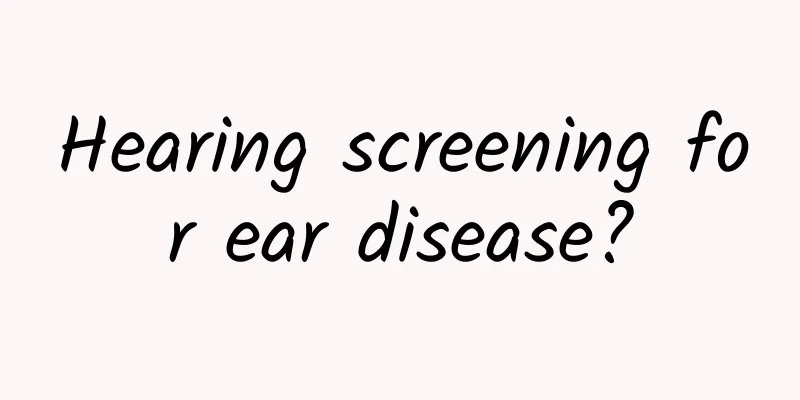Hearing screening for ear disease?

|
A hearing test is to observe the health of the baby's ears through targeted tests. Because many newborns have certain hearing imperfections after birth, targeted tests are needed to find out the problem in time and then provide treatment. Newborns do not understand their hearing and cannot express it, so parents must pay attention to it. What is hearing screening? It is an objective, rapid and non-invasive examination performed on newborns in their natural sleep or quiet state after birth through electrophysiological tests such as otoacoustic emissions, automatic auditory brainstem response and acoustic impedance. Domestic and foreign reports indicate that the incidence of hearing loss in normal newborns and newborns with high-risk factors is quite different, with normal newborns being approximately 1%o to 3‰ and high-risk newborns being approximately 2% to 4%. Diagnostic Hearing Evaluation Infants and young children who fail the rescreening should receive audiological and medical evaluations at 3 months of age to ensure that congenital or permanent hearing loss is determined within 6 months of age so that intervention can be implemented. That is, children who fail the re-screening should undergo otolaryngology examination and acoustic impedance, otoacoustic emissions, auditory brainstem evoked potential testing, behavioral audiometry and other related examinations by a hearing testing agency. If necessary, medical and imaging evaluations should also be conducted to make a diagnosis. For children with high risk factors for hearing loss, the timing and frequency of individualized hearing reassessments should be determined based on the potential for delayed hearing loss. For infants and young children who pass the newborn hearing screening but have high-risk factors for hearing loss, hearing follow-up should be conducted at least once every 6 months for the first 3 years of age. If hearing loss is suspected, an audiological evaluation should be performed in a timely manner. 1. Test time: 3 months to 6 months after birth. 2. Test environment requirements: Sound-proof shielded room with ambient noise below 30dB(A) 3. Objective hearing test items include: diagnostic OAE, 1kHz acoustic immittance test, short sound and short pure tone ABR, AERP, ASSR and bone conduction ABR, etc. 4. Subjective hearing test items include: pediatric behavioral audiometry (BOA, VRA, PA, PTA), speech testing and auditory-speech development assessment form. Newborn hearing screening, diagnosis and intervention is a complete hearing rehabilitation system project. Intervention measures are the final link and are the key to showing the results of congenital deafness rehabilitation. The method used and when to intervene are important for the hearing, speech and language rehabilitation of children. Interventions include medical intervention, hearing compensation or reconstruction, and auditory function training and speech rehabilitation training. 1. Medical intervention Medical intervention is when a physician makes a medical diagnosis, i.e. the cause, extent, and location of hearing loss, and uses treatment to restore hearing. Earwax in the external auditory canal: In newborns and infants, there is too much earwax and it is difficult to be discharged naturally, which may block the external auditory canal. In this case, the use of otoacoustic emission testing can often cause the otoacoustic emission energy to disappear, and may also affect the acoustic impedance test, so the external auditory canal cerumen must be cleared. Acute secretory otitis media: Acute secretory otitis media in infancy and childhood is often caused by upper respiratory tract infection and immune allergy. It can cause tympanic effusion and hearing loss. It can be diagnosed based on clinical symptoms, ear microscopic examination, and audiological examination, including otoacoustic emissions and acoustic impedance examination. Etiological treatment can be used, steroid hormones and anti-allergic drugs can be used, and ephedrine can be dropped into the nasal cavity. If drug treatment is ineffective, transtympanic membrane puncture and drainage, incision and drainage, and transtympanic membrane ventilation tube installation can be used. To improve and restore the hearing of children. |
<<: What causes pain in the ear piercing?
>>: What is the reason why the ears feel blocked after being slapped?
Recommend
Can I get Hepatitis B by kissing the breasts of a woman with Hepatitis B?
Hepatitis B is a disease that is contagious to a ...
The efficacy, effects and contraindications of Polygonum multiflorum
Polygonum multiflorum, also known as Polygonum mu...
Is the thick leucorrhea like paste caused by ovulation?
In real life, women's leucorrhea is also part...
The toxic side effects of walnut wood
The toxic side effects of walnut pith may cause p...
The nature and flavor of lotus leaf
Lotus leaves are the leaves of the lotus, an aqua...
How to remove baby pigmentation
White teeth make people's smiles more attract...
Daily waist protection tips for the elderly
Who doesn’t have elderly people in their family? ...
Gum side teeth
Everyone has the chance of growing wisdom teeth, ...
What medicine should I take for kidney yin deficiency?
The disease of kidney yin deficiency has now been...
Recipe for dehumidifying tea, drink these three for best results
People who have dampness in their bodies are usua...
The benefits of knee tapping
There are many ways to exercise in daily life. Pa...
What to do if your knees hurt while running?
Be sure to pay attention to knee pain when runnin...
Emergency treatment and four stages of recovery for ankle sprains
Life lies in exercise. Many people like to exerci...
What medicine should be used for tongue sores
Tongue sores are very painful. There are many sma...
Pepsinogen
In biology class, we often hear biology teachers ...









